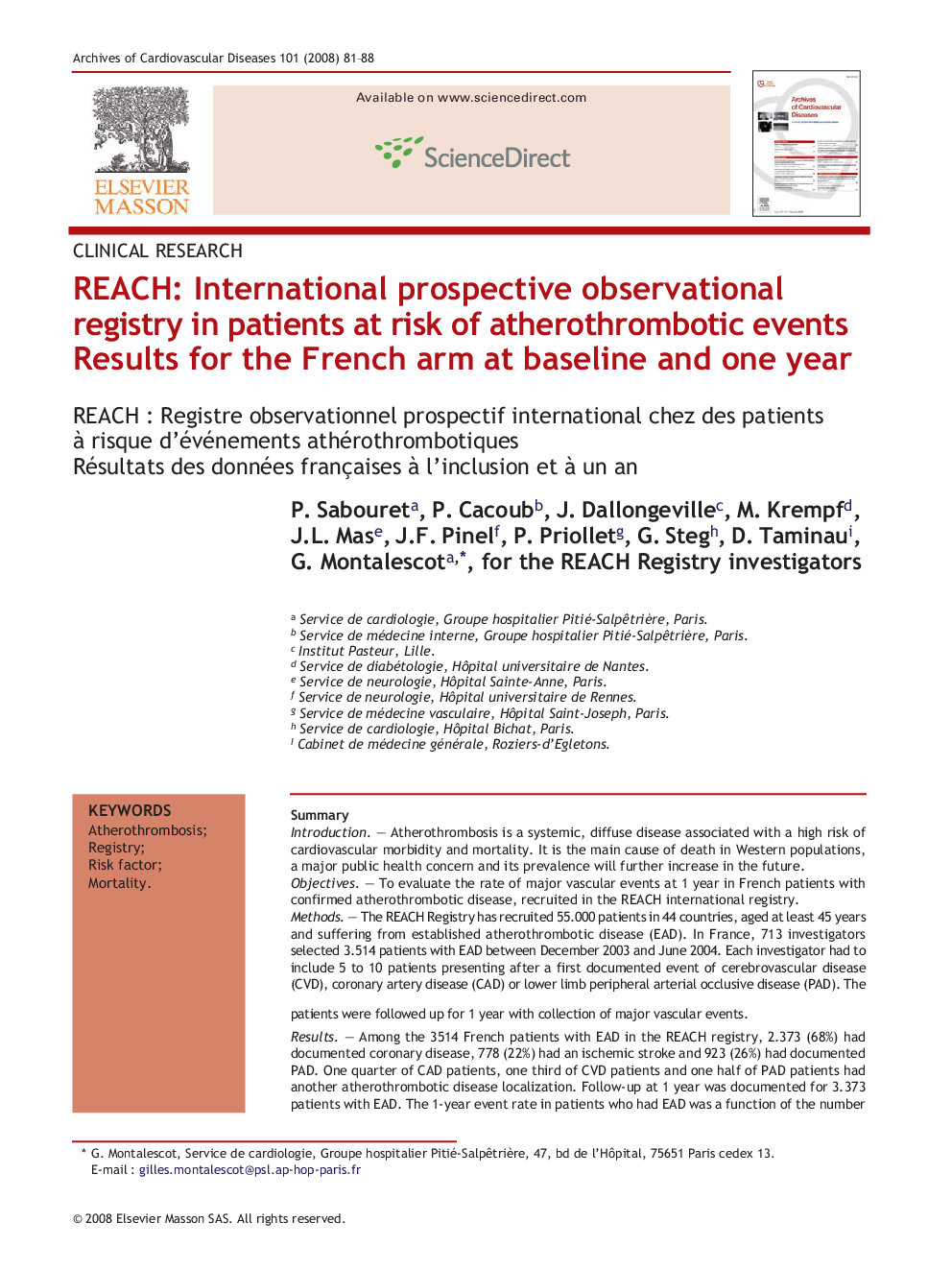| کد مقاله | کد نشریه | سال انتشار | مقاله انگلیسی | نسخه تمام متن |
|---|---|---|---|---|
| 2890044 | 1574418 | 2008 | 8 صفحه PDF | دانلود رایگان |

SummaryIntroductionAtherothrombosis is a systemic, diffuse disease associated with a high risk of cardiovascular morbidity and mortality. It is the main cause of death in Western populations, a major public health concern and its prevalence will further increase in the future.ObjectivesTo evaluate the rate of major vascular events at 1 year in French patients with confirmed atherothrombotic disease, recruited in the REACH international registry.MethodsThe REACH Registry has recruited 55.000 patients in 44 countries, aged at least 45 years and suffering from established atherothrombotic disease (EAD). In France, 713 investigators selected 3.514 patients with EAD between December 2003 and June 2004. Each investigator had to include 5 to 10 patients presenting after a first documented event of cerebrovascular disease (CVD), coronary artery disease (CAD) or lower limb peripheral arterial occlusive disease (PAD). The patients were followed up for 1 year with collection of major vascular events.ResultsAmong the 3514 French patients with EAD in the REACH registry, 2.373 (68%) had documented coronary disease, 778 (22%) had an ischemic stroke and 923 (26%) had documented PAD. One quarter of CAD patients, one third of CVD patients and one half of PAD patients had another atherothrombotic disease localization. Follow-up at 1 year was documented for 3.373 patients with EAD. The 1-year event rate in patients who had EAD was a function of the number of atherothrombotic localizations: the vascular death rate was 1.8% if there was a single localization and 4.1% if there were 2 or 3 localizations, and the composite death, infarct and stroke rates were 3.8% and 7.2% respectively and 11.7% and 22.3% respectively if hospitalizations were added to the latter endpoint.ConclusionThe number of major vascular events during the first year is high in EAD patients although these patients were followed up on an outpatient basis and are considered to be stable. In patients with prior EAD, there was a close link between the incidence of major vascular events and the number of symptomatic arterial beds (2 or 3 sites). The risk of a major vascular event was twice as high in patients with polyvascular involvement than in those who only had one affected artery.
RésuméIntroductionL’athérothrombose, maladie globale et diffuse, est associée à un risque élevé de morbi-mortalité cardio-vasculaires. Elle est la principale cause de décès dans la population occidentale, véritable enjeu de santé publique et sa prévalence va augmenter dans les prochaines années.ObjectifsÉvaluer le taux d’événements vasculaires majeurs à 1 an chez les patients français ayant une maladie athérothrombotique établie, inclus dans le registre international REACH.MéthodesLe registre REACH a inclus 55 000 patients dans 44 pays, âgés d’au moins 45 ans et souffrant d’une maladie athérothrombotique établie (MAE). En France, 713 médecins investigateurs ont sélectionné 3 514 patients avec MAE entre décembre 2003 et juin 2004. Chaque investigateur devait inclure 5 à 10 patients se présentant après un premier événement documenté de maladie coronaire, cérébrovasculaire, ou souffrant d’une artériopathie oblitérante des membres inférieurs (AOMI). Les patients ont été suivis pendant 1 an avec recueil des événements vasculaires majeurs.RésultatsParmi les 3 514 patients français ayant une MAE du registre REACH, 2 373 (68 %) avaient une maladie coronaire documentée, 778 (22 %) avaient une maladie ischémique cérébrovasculaire et 923 (26 %) avaient une AOMI documentée. Un quart des coronariens, un tiers des patients avec atteinte cérébrovasculaire et la moitié des artéritiques ont une autre localisation athérothrombotique. Le suivi à 1 an a été documenté chez 3 373 patients ayant une MAE. Le taux d’événements à 1 an chez les patients ayant une MAE est fonction du nombre de localisations athérothrombotiques : le taux de décès vasculaire est de 1,8 % s’il existe une seule localisation athérothrombotique et de 4,1 % s’il y a 2 ou 3 localisations athérothrombotiques, le taux du critère combiné de décès, infarctus et AVC est de 3,8 % et de 7,2 % respectivement et de 11,7 % et 22,3 % respectivement si les hospitalisations sont ajoutées au critère précédent.ConclusionLe nombre d’événements vasculaires majeurs à 1 an est élevé chez les patients avec MAE alors qu’il s’agit de patients suivis en ambulatoire et considérés comme stables. Chez les patients ayant une MAE, il existe une relation étroite entre la fréquence de survenue des événements vasculaires majeurs et le nombre de lits artériels symptomatiques (2 ou 3 localisations). Les patients ayant une atteinte polyvasculaire ont à ce titre un risque d’événements vasculaires majeurs doublé par rapport à ceux qui n’ont qu’une seule atteinte artérielle.
Journal: Archives of Cardiovascular Diseases - Volume 101, Issue 2, January 2008, Pages 81–88